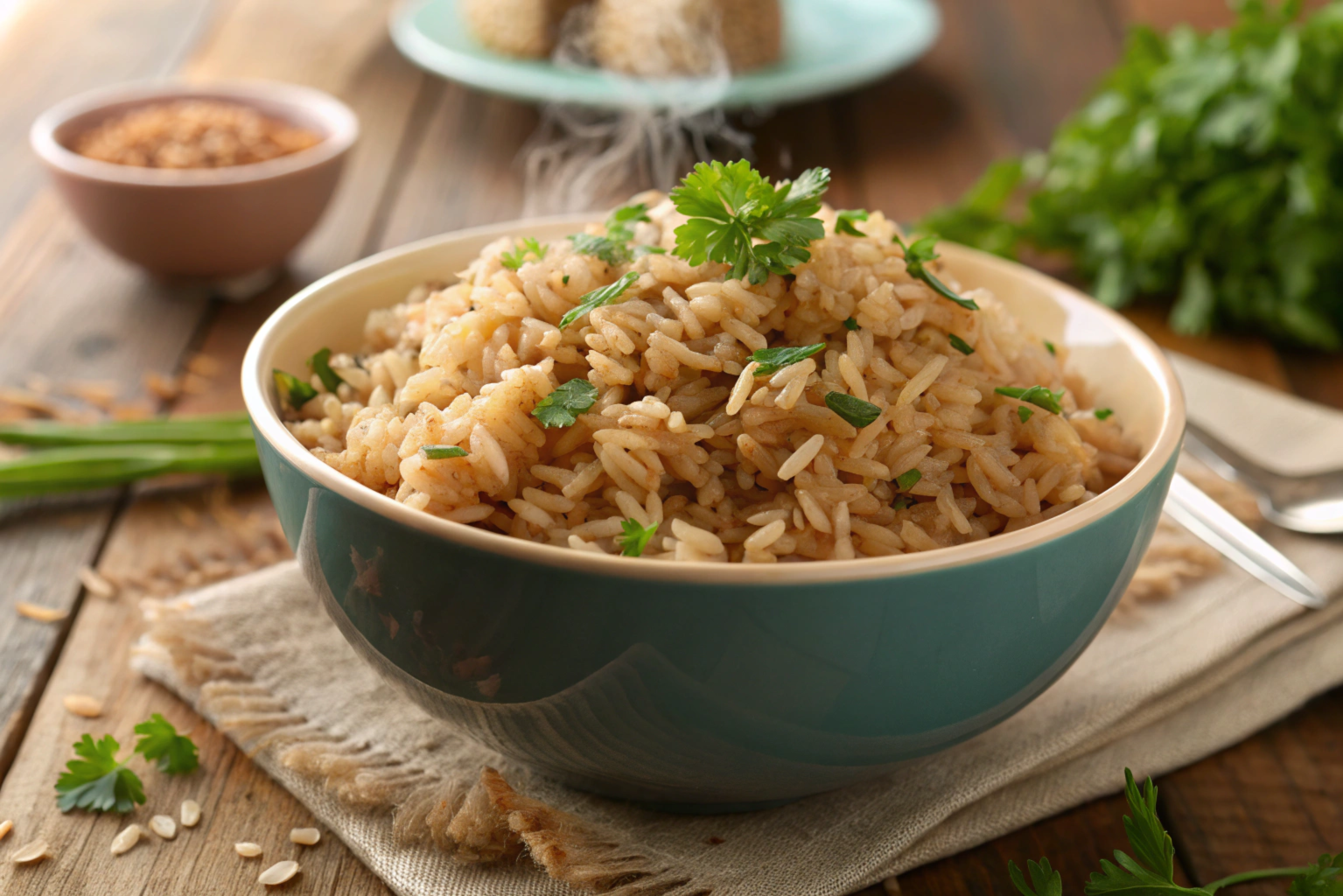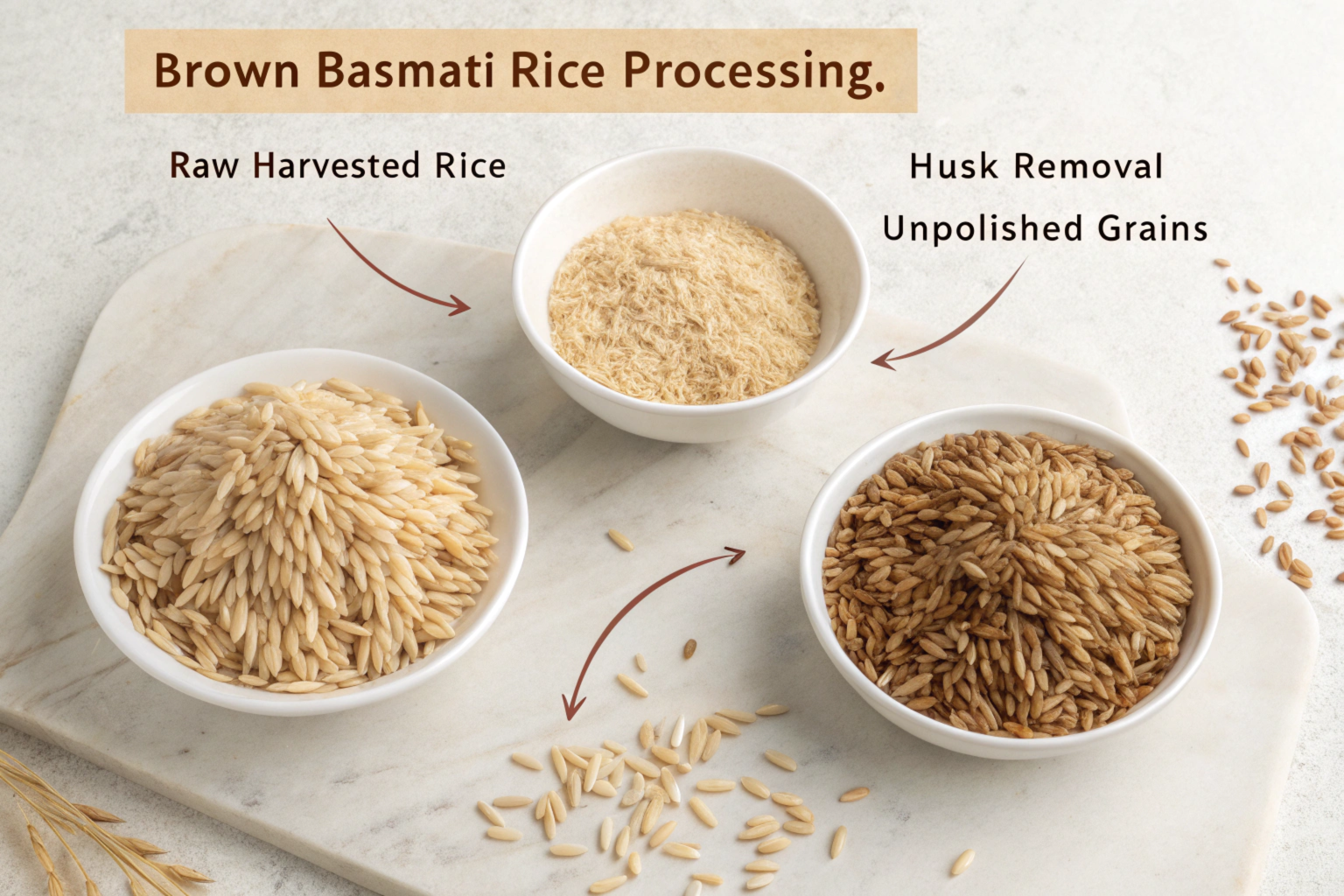Introduction
Brown basmati rice is a culinary gem prized for its distinct aroma, rich flavor, and nutritional benefits. Many wonder, is brown basmati rice natural? This question dives deep into its cultivation, processing, and inherent qualities. Throughout this article, we’ll explore its natural composition, nutritional benefits, health advantages, and much more, unraveling what makes it a staple in diets worldwide. Let’s start by understanding the basics.
Understanding Brown Basmati Rice
Definition and Origin
Brown basmati rice, a type of long-grain rice, is known for its nutty flavor and firm texture. Unlike its white counterpart, it retains the bran and germ layers, making it a whole grain. This rice variety primarily hails from South Asia, particularly India and Pakistan, where its cultivation dates back centuries.
The word “basmati” itself means fragrant in Hindi, reflecting the naturally aromatic nature of this grain. As a result of its minimal processing, brown basmati rice maintains its earthy taste and nutritional integrity.
Distinct Characteristics
What sets brown basmati rice apart? Its long, slender grains not only cook to a fluffy consistency but also emit a unique aroma. The natural oils in the bran layer contribute to its fragrance, giving it a distinctive identity among other rice varieties.
Moreover, its golden-brown hue hints at its unpolished state, a key feature for those seeking wholesome, unrefined grains. Whether paired with savory curries or tossed into salads, its versatility shines through.
Cultivation Regions
Brown basmati rice thrives in the fertile plains of the Indian subcontinent, nurtured by Himalayan river waters. Punjab, Haryana, and Uttar Pradesh in India are significant producers, along with areas in Pakistan. These regions, blessed with ideal soil and climatic conditions, ensure the natural quality of basmati rice.
Through sustainable farming methods and traditional practices, farmers have preserved the authenticity of this rice, delivering a product that resonates with nature’s purity.
Natural Composition of Brown Basmati Rice
Is Brown Basmati Rice Natural?
The question, is brown basmati rice natural?, is integral to understanding its value. Brown basmati rice is indeed natural, primarily because it undergoes minimal processing. Unlike white rice, it retains its bran and germ layers, making it closer to its original harvested state. These layers are rich in nutrients, contributing to its wholesome appeal.
Furthermore, brown basmati rice is grown without genetic modification in most traditional farming practices, especially in South Asia. This grain exemplifies a food product that maintains its authenticity and nutritional integrity. Farmers rely on organic or sustainable methods to cultivate it, ensuring it is free from artificial enhancers or additives.
By choosing brown basmati rice, you’re opting for a product that aligns with the principles of natural, whole foods. It’s a grain that provides not only sustenance but also a direct connection to its agricultural roots.
Processing Methods
The processing of brown basmati rice is straightforward, which is why it is often regarded as a natural grain. After harvesting, the rice undergoes husk removal, leaving the bran and germ layers intact. These layers are pivotal, as they house essential nutrients like fiber, vitamins, and minerals.
Unlike white rice, which is polished and stripped of its bran and germ for a refined appearance and longer shelf life, brown basmati rice retains its earthy composition. This minimal intervention helps preserve its natural oils, contributing to its nutty flavor and characteristic aroma.
However, careful handling is required to maintain the rice’s freshness. The retained bran layer contains natural oils that can turn rancid if not stored properly. But with proper care, brown basmati rice remains a shelf-stable and natural choice for health-conscious consumers.
(Link out: Learn more about the differences in processing methods on Nutritional Differences Between Brown and White Basmati Rice.)
Comparison with White Basmati Rice
Brown basmati rice is vastly different from its white counterpart in terms of both composition and benefits. While both originate from the same grain, the processing diverges significantly after harvest. White basmati rice undergoes a polishing process that removes the bran and germ layers, leaving only the starchy endosperm. This results in a grain that cooks faster and has a milder flavor but loses much of its natural nutrients.
On the other hand, brown basmati rice, being unpolished, retains a higher amount of dietary fiber, magnesium, and B vitamins. Its higher fiber content makes it more filling, aiding in weight management and better digestion. The bran layer in brown basmati rice also contributes to its slightly chewy texture and richer taste compared to the fluffier and milder profile of white basmati rice.
When considering its natural composition, brown basmati rice clearly stands out. It embodies a whole grain approach, making it a healthier and more natural option for individuals prioritizing nutritional benefits.
Nutritional Profile
Nutritional Content of Brown Basmati Rice
Brown basmati rice boasts a robust nutritional profile, making it a popular choice among health enthusiasts. As a whole grain, it retains the bran and germ layers, which are rich in essential nutrients. These components contribute significantly to its nutritional superiority compared to polished varieties like white basmati rice.
This natural grain is an excellent source of complex carbohydrates, providing sustained energy throughout the day. Additionally, it is low in fat and contains no cholesterol, making it a heart-friendly option. With a moderate glycemic index, brown basmati rice supports steady blood sugar levels, catering to those managing diabetes or looking for a balanced diet.
Each serving of cooked brown basmati rice (about one cup) offers a wholesome mix of macronutrients, micronutrients, and dietary fiber, delivering a meal that is not only filling but also nutritionally rich.
Macronutrients
Brown basmati rice is a well-rounded source of the three essential macronutrients: carbohydrates, protein, and fat. Carbohydrates make up the majority of its content, providing the body with a steady and reliable energy source. Unlike refined grains, the carbohydrates in brown basmati are paired with fiber, slowing digestion and preventing energy spikes.
In terms of protein, brown basmati rice contains about 5 grams per cup of cooked rice. While it’s not a complete protein, pairing it with legumes or vegetables can create a balanced meal with all essential amino acids.
Fat content in brown basmati rice is minimal, clocking in at less than 1 gram per serving. Moreover, the fats it does contain are natural and healthy, derived from the oils in the bran layer. This makes it suitable for those following low-fat diets while still seeking whole food options.
(Link out: Learn more about its macronutrient benefits at Health Benefits of Basmati Rice.)
Micronutrients
One of the standout qualities of brown basmati rice is its abundance of essential micronutrients. It is particularly rich in magnesium, a mineral vital for muscle function, bone health, and energy production. A single serving can provide about 20% of the daily recommended magnesium intake.
Other notable micronutrients include B vitamins like thiamine (B1) and niacin (B3), which are crucial for converting food into energy. Additionally, brown basmati rice contains trace amounts of zinc and selenium, both of which support immune function and antioxidant activity.
The bran layer is also a natural source of manganese, a mineral that aids in bone health and metabolic processes. These micronutrients, preserved during minimal processing, underscore the grain’s value as a nutrient-dense food.
Fiber Content
Dietary fiber is one of the primary reasons brown basmati rice is celebrated as a health food. With nearly 4 grams of fiber per cup of cooked rice, it offers about 15% of the recommended daily intake for most adults. This fiber content contributes to several health benefits, from improved digestion to enhanced heart health.
Soluble fiber in brown basmati rice helps regulate blood sugar levels, making it an excellent choice for individuals managing diabetes. Insoluble fiber, on the other hand, promotes gut health by facilitating regular bowel movements and reducing the risk of constipation.
Moreover, dietary fiber plays a role in weight management by promoting satiety, which can help prevent overeating. By incorporating brown basmati rice into meals, individuals can enjoy a wholesome food that supports overall well-being without compromising on taste or satisfaction.
Health Benefits
Health Benefits of Brown Basmati Rice
Brown basmati rice is more than just a delicious addition to your plate; it’s a powerhouse of health benefits. As a whole grain, it retains its nutrient-rich bran and germ layers, delivering a combination of essential nutrients and dietary fiber. These elements make it a valuable choice for those aiming to lead a healthier lifestyle.
From aiding in weight management to supporting heart health, brown basmati rice provides a range of benefits that go beyond basic nutrition. Its moderate glycemic index and rich nutrient profile make it particularly beneficial for individuals managing blood sugar levels or looking to prevent chronic diseases.
Weight Management
If you’re striving for a healthier weight, brown basmati rice can be a valuable ally. Its high fiber content plays a crucial role in promoting satiety, meaning you’ll feel fuller for longer after eating. This can help curb unnecessary snacking and reduce overall calorie intake without feeling deprived.
The complex carbohydrates in brown basmati rice provide a steady release of energy, helping to avoid the spikes and crashes associated with processed carbs. By keeping energy levels stable, it supports better portion control and consistent meal patterns.
Moreover, the protein content in brown basmati rice contributes to its filling nature. While not a high-protein food, when combined with other sources like beans or lentils, it becomes part of a satisfying and nutrient-dense meal, perfect for weight-conscious individuals.
(Link out: Discover how brown rice aids in weight management at Health Benefits of Basmati Rice.)
Heart Health
Brown basmati rice is a heart-friendly food, thanks to its low fat content and the presence of heart-healthy nutrients. Magnesium, a key mineral in brown basmati rice, is essential for maintaining a regular heartbeat and supporting overall cardiovascular health.
Additionally, its dietary fiber helps reduce bad cholesterol (LDL) levels in the blood, which can lower the risk of heart disease. Studies suggest that incorporating whole grains like brown basmati rice into your diet can significantly contribute to long-term heart health by improving lipid profiles and reducing arterial inflammation.
The natural oils in the bran layer also contain beneficial antioxidants, which protect cells from oxidative stress, another factor contributing to cardiovascular disease. A diet rich in whole grains, including brown basmati rice, can thus be a preventive measure for heart-related issues.
Blood Sugar Control
Managing blood sugar levels is a priority for many, and brown basmati rice excels in this area. With a glycemic index lower than that of white rice, it causes a slower, more controlled rise in blood sugar after meals. This makes it an excellent choice for individuals with diabetes or those aiming to prevent it.
The fiber content in brown basmati rice further aids in regulating blood sugar by slowing the absorption of carbohydrates into the bloodstream. This steady release of glucose helps maintain energy levels while preventing the spikes and crashes associated with high-glycemic foods.
Magnesium, found in brown basmati rice, plays an additional role in blood sugar management. It’s essential for the body’s ability to use insulin effectively, further supporting stable glucose levels. By integrating brown basmati rice into a balanced diet, you’re not only enjoying a delicious meal but also actively managing your blood sugar.
Culinary Uses
Culinary Applications of Brown Basmati Rice
Brown basmati rice isn’t just healthy; it’s also incredibly versatile in the kitchen. Its unique nutty flavor and chewy texture make it a favorite ingredient in both traditional and contemporary dishes. Whether it’s featured as the star of a recipe or a complementary side, brown basmati rice adapts beautifully to a range of culinary styles.
From hearty South Asian classics to modern health-conscious creations, this whole grain adds a touch of natural goodness to every meal. Moreover, the cooking techniques you choose can significantly enhance its flavor and texture, transforming it into a dish that’s both satisfying and nutritious.
Traditional Dishes
Brown basmati rice holds a revered place in South Asian cuisine, where it serves as the base for many beloved dishes. In biryanis, for instance, its aromatic grains meld with rich spices, vegetables, and proteins to create a flavorful and fragrant one-pot meal.
Similarly, it’s used in pulao, a lighter rice dish cooked with whole spices, broth, and vegetables. Brown basmati rice’s earthy taste pairs beautifully with the robust flavors of curries like chana masala or dal tadka. For those embracing a whole-grain diet, substituting white basmati with brown adds a nutritious twist without sacrificing authenticity.
Another traditional favorite is khichdi, a comforting porridge-like dish made with rice and lentils. When made with brown basmati rice, it becomes a heartier and more fiber-rich version of this classic comfort food.
(Link out: Explore more about the health benefits of brown rice-based dishes at Health Benefits of Basmati Rice.)
Modern Recipes
Brown basmati rice has seamlessly made its way into modern, global cuisine. Its wholesome qualities make it a popular choice for grain bowls, where it’s paired with roasted vegetables, leafy greens, and protein-rich toppings like grilled chicken or chickpeas.
For a lighter option, it can be used in stir-fry recipes with colorful veggies and a savory soy-ginger sauce. Brown basmati rice’s natural flavor also complements Mediterranean-inspired dishes, such as rice pilafs with nuts, dried fruits, and fresh herbs.
In vegan and vegetarian cooking, brown basmati rice shines as the base for stuffed peppers or as a component in homemade veggie burgers. The possibilities are endless, as its versatility lends itself to both savory and sweet preparations, including rice pudding made with almond milk and a dash of cinnamon.
Cooking Techniques
Mastering the art of cooking brown basmati rice ensures the best flavor and texture in your dishes. A common technique is to rinse the rice thoroughly before cooking. This step removes excess starch, preventing clumping and ensuring fluffy, separate grains.
For perfect results, a typical ratio of water to rice is about 2.5:1, though this may vary slightly depending on your preference for texture. Boil the water first, add the rice, and let it simmer on low heat with the lid on until the water is fully absorbed.
Another popular method is the soak-and-drain technique. Soaking brown basmati rice for 30 minutes before cooking helps soften the bran layer, reducing cooking time and enhancing its tender yet firm texture. You can also use a rice cooker or pressure cooker for a hands-off approach, ensuring consistency every time.
Finally, incorporating aromatics like bay leaves, cinnamon, or cardamom during the cooking process can elevate the natural fragrance of brown basmati rice, creating a dish that’s both aromatic and flavorful.
Frequently Asked Questions
FAQs about Brown Basmati Rice
Curiosity about brown basmati rice often leads to common questions surrounding its health benefits, storage, and dietary suitability. Below, we address some of the most frequently asked queries to help you better understand this versatile and nutritious grain.
Is brown basmati rice healthier than white rice?
Yes, brown basmati rice is generally considered healthier than white rice due to its higher nutritional content. Unlike white rice, which undergoes extensive polishing that removes the bran and germ layers, brown basmati rice retains these nutrient-rich components. This means it’s a great source of dietary fiber, essential minerals like magnesium and manganese, and B vitamins.
Additionally, its lower glycemic index helps regulate blood sugar levels, making it a better choice for individuals with diabetes. While both types of rice provide carbohydrates, the fiber in brown basmati rice slows digestion, ensuring a steady release of energy and longer-lasting satiety.
Is Brown Basmati Rice Healthier Than White Rice?
Absolutely! Brown basmati rice is a healthier choice compared to white rice. Why? It’s all about what it keeps intact. While white rice is polished and stripped of the bran and germ layers, brown basmati rice holds onto these nutrient-packed components. That means it’s loaded with dietary fiber, magnesium, manganese, and essential B vitamins.
Thanks to its fiber content, brown basmati rice helps with digestion and keeps you feeling fuller for longer. It also has a lower glycemic index, making it great for managing blood sugar levels. Unlike white rice, which can cause quick spikes, brown basmati rice releases energy more steadily—an ideal trait for anyone focusing on a balanced diet or diabetes management.
How Should Brown Basmati Rice Be Stored?
Proper storage is the secret to keeping brown basmati rice fresh and flavorful. Since it retains the natural oils in its bran layer, it’s more prone to spoilage compared to white rice. But don’t worry—simple steps can preserve its quality.
Store your rice in an airtight container to shield it from moisture, pests, and air exposure. Place the container in a cool, dark spot, like a pantry or cupboard. Avoid areas with heat or direct sunlight. For long-term storage, refrigerating or freezing the rice is a great option. When stored properly, brown basmati rice can last up to six months at room temperature or up to a year in the freezer.
Does Brown Basmati Rice Contain Gluten?
Nope! Brown basmati rice is naturally gluten-free, making it a perfect choice for people with celiac disease or gluten sensitivities. This grain is a fantastic alternative to wheat-based products and fits seamlessly into a gluten-free lifestyle.
Its versatility means you can use it in countless dishes, from hearty grain bowls to risottos and even as a side for curries or roasted veggies. It’s not just healthy—it’s also incredibly delicious!



